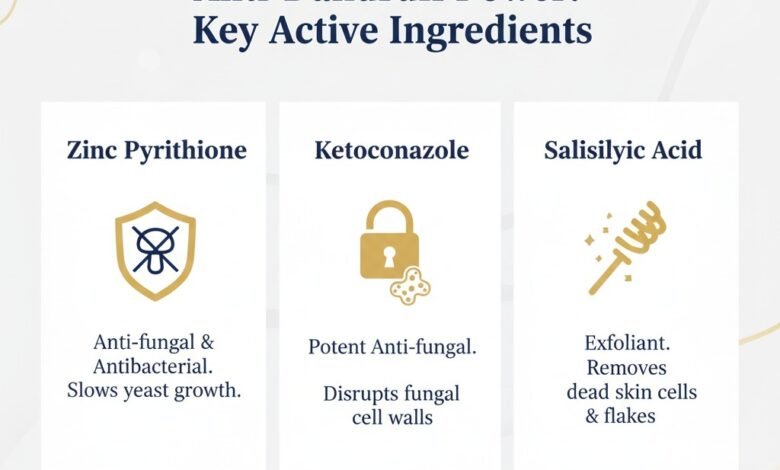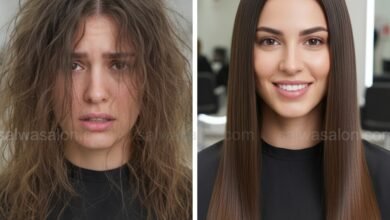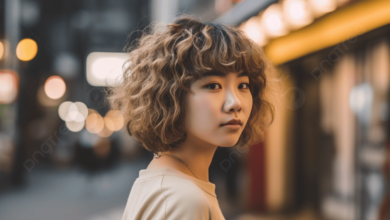Salwa Salon Reveals: A Scientific and Practical Guide to Overcoming Stubborn Dandruff for Optimal Scalp Health

At SalwaSalon.com, we understand that dandruff is not merely an aesthetic issue, but a reflection of the complex and often overlooked health of the scalp. For over a decade, deeply involved in the world of beauty and hair care, we have witnessed how stubborn dandruff can erode self-confidence and even disrupt daily comfort. Many individuals experience it, from teenagers to middle-aged adults, often without understanding the true root causes or effective solutions.
This article serves as an in-depth educational guide from Salwa Salon, designed to equip you with comprehensive knowledge. We will delve into ‘why’ dandruff appears, ‘what’ its differences are based on type, and ‘how’ science-backed treatment strategies can help you achieve optimal scalp health. Prepare to immerse yourself in the world of scalp health and discover practical, in-depth, and inspiring solutions proven by our experience.
Understanding Dandruff: More Than Just Flakes
Dandruff, or medically known as Pityriasis capitis, is a scalp condition characterized by excessive shedding of dead skin cells, often accompanied by itching and irritation. While often considered trivial, persistent dandruff can be an indicator of an imbalance in your scalp’s micro-ecosystem. We will outline the key symptoms you need to recognize:
Key Dandruff Symptoms to Watch Out For
- Scalp Flakes: This is the most common symptom, appearing as grayish-white or yellowish flakes clearly visible on hair and clothing. These flakes can be fine and dry (dry dandruff) or thicker, oily, and adherent (oily dandruff).
- Intolerable Itching (Pruritus): Itching is the body’s natural response to irritation and inflammation on the scalp. Scratching can worsen the condition, leading to wounds, and even secondary infections.
- Red and Irritated Scalp: Inflammation is at the core of dandruff problems. The scalp may appear reddish, feel sore, and even swell in severe cases, indicating an immune response to irritants or fungi.
- Oily Scalp (Seborrhoea): Especially with oily dandruff, excessive sebum production creates an ideal environment for the growth of Malassezia fungus, which then exacerbates dandruff.
- Limp and Dull Hair: The buildup of dead skin cells and oil can make hair look limp, dull, and lack volume, even after washing.
- Hair Loss: While dandruff does not directly cause baldness, chronic inflammation, follicle blockage by flakes, and trauma from excessive scratching can lead to increased hair shedding.
Two Faces of Dandruff: Dry vs. Oily
Distinguishing between dandruff types is a crucial step in determining the right treatment strategy. From Salwa Salon’s perspective, this classification is rooted in the dynamics of sebum production and your scalp’s response.
Comparing Dry Dandruff and Oily Dandruff
- Dry Dandruff (Pityriasis Simplex Capitis):
- Flake Form: Small, fine, silvery-white flakes, easily detached and falling.
- Scalp Condition: Tends to be dry, sometimes feeling tight or taut. Sebum production is normal or low.
- Main Causes: Scalp dehydration, dry weather, use of irritating products, or excessive washing with hot water that strips natural oils. Sensitivity to certain products can also be a trigger.
- Itching: Present, but may not be as intense as oily dandruff.
- Wet / Oily Dandruff (Seborrhoeic Dermatitis):
- Flake Form: Larger, thicker, oily, yellowish flakes that tend to stick to hair and scalp. Difficult to dislodge.
- Scalp Condition: Oily, reddish, and often inflamed. Excessive sebum production (seborrhoea) is a hallmark.
- Main Causes: Overproduction of sebum by the sebaceous glands, which then becomes food for the Malassezia globosa fungus. The inflammatory reaction to this fungus’s byproducts causes accelerated skin cell shedding.
- Itching: Often very intense and persistent.
Understanding these differences will guide you toward more specific and effective product choices and care habits.
Uncovering the Root Cause: Factors Contributing to Stubborn Dandruff
A fundamental question we often hear at Salwa Salon is: “Why does dandruff always come back?” The answer lies in the complex interaction between internal and external factors. We will review them in depth:
Biological and Pathological Factors
- Malassezia globosa Fungus: This is the primary culprit behind most dandruff cases. Malassezia is a yeast that naturally lives on everyone’s scalp. However, in susceptible individuals, this fungus can proliferate excessively, especially in sebum-rich scalp environments. When Malassezia digests sebum, it produces oleic acid as a byproduct. For some, this oleic acid triggers an inflammatory response, which accelerates scalp cell turnover, resulting in dandruff flakes.
- Seborrheic Dermatitis: This is a more severe form of dandruff, characterized by an oily, red, thickly scaled, and severely itchy scalp. This condition can also affect other oil gland-rich areas such as the face, chest, and back. Malassezia plays a central role in its pathogenesis.
- Scalp Psoriasis: Unlike seborrheic dermatitis, psoriasis is a chronic autoimmune disease that causes skin cells to grow too quickly. On the scalp, it manifests as thick red patches with silvery, scaling flakes, often larger and more adherent than regular dandruff.
- Hormonal Factors: Androgens (male hormones) are known to stimulate sebum production. This explains why dandruff is often more severe in men or during puberty when hormonal fluctuations occur.
Lifestyle and Environmental Factors
- Excessive Stress: Stress does not directly cause dandruff but can worsen existing conditions. Stress triggers the release of cortisol, which can suppress the immune system and disrupt the scalp’s microbiome balance, making you more susceptible to Malassezia overgrowth.
- Diet and Nutrition: A diet lacking essential nutrients such as zinc, B-complex vitamins, and omega-3 fatty acids can affect scalp health and immune function. Consumption of high-sugar and high-saturated fat foods can also trigger inflammation.
- Improper Washing Habits:
- Infrequent Washing: Allows the buildup of oil, dead skin cells, and hair products, creating an ideal environment for Malassezia.
- Over-Washing or Hot Water: Can excessively strip natural scalp oils, leading to dryness and irritation, especially for dry dandruff.
- Unsuitable Hair Care Products: Residue from shampoos, conditioners, gels, or hairsprays that are not rinsed thoroughly can clog follicles and irritate the scalp. Harsh chemicals, high alcohol content, or certain fragrances can also trigger allergic reactions or irritation.
- Poor Hair Care Tool Hygiene: Combs, brushes, and towels that are rarely washed can become breeding grounds for bacteria and fungi, spreading them back to your scalp.
- Prolonged Use of Hats or Headscarves: A humid environment and lack of air circulation under hats or headscarves create ideal conditions for fungal growth.
Salwa Salon’s Comprehensive Strategy: Overcoming Stubborn Dandruff
Having understood the complexity behind dandruff, it’s time to turn to solutions. Our approach at Salwa Salon combines scientific knowledge with proven care practices, ensuring optimal and sustainable results.
1. Optimizing the Use of Special Anti-Dandruff Shampoos
Shampoo selection is the primary foundation. It’s not just about changing shampoos, but understanding the active ingredients they contain and how they work:
- Zinc Pyrithione: An antifungal and antibacterial ingredient effective against Malassezia globosa. Ideal for mild to moderate dandruff.
- Selenium Sulfide: An antifungal agent that also reduces the rate of scalp cell turnover. Suitable for more persistent dandruff cases.
- Ketoconazole: A powerful broad-spectrum antifungal, often prescribed for seborrheic dermatitis or very stubborn dandruff.
- Salicylic Acid: A keratolytic agent that helps loosen and lift adherent dandruff flakes, suitable for dandruff with thick scales.
- Coal Tar: Works by slowing down scalp cell growth and reducing inflammation. Effective for scalp psoriasis and severe seborrheic dermatitis, but requires caution due to its strong odor and potential to stain light hair.
Usage Guidelines: Use regularly as directed, allowing the lather to sit on the scalp for several minutes before rinsing, and ensure thorough rinsing to avoid residue. For stubborn cases, rotation of several types of anti-dandruff shampoos may be necessary.
2. Maintaining Scalp Microbiome and Oil Balance
Balance is key. Washing hair too often or too infrequently is equally detrimental. The ideal washing frequency varies for each individual, depending on hair type, activity level, and scalp sebum production.
- Oily Scalp/High Activity: Washing daily or every other day can help control oil and fungal buildup.
- Dry Scalp/Normal Hair: Washing two to three times a week may be sufficient. Use lukewarm water, not hot water, to prevent excessive stripping of natural oils.
3. Evaluating Hair Care Products
The products you use can trigger or worsen dandruff. Avoid:
- High-Alcohol Products: Alcohol can dry out the scalp and trigger excessive oil production as compensation.
- Products with Artificial Fragrances and Dyes: Can cause irritation or allergic reactions on sensitive scalps.
- Products with Heavy Silicones or Excessive Mineral Oils: Potentially clog follicles and create an anaerobic environment for fungi.
Choose products with light formulas, hypoallergenic, and non-comedogenic (non-pore-clogging).
4. Hair Care Tool Hygiene
This is a simple yet crucial step often overlooked. Combs, brushes, pillows, and towels are ideal places for fungi and bacteria to transfer and thrive. Wash your combs and hairbrushes at least once a week with soap and warm water. Change pillowcases regularly and ensure your towels are always clean.
5. Utilizing Natural Ingredients with a Scientific Approach
Several natural ingredients have properties that support dandruff treatment, but it’s important to understand their mechanisms and use them wisely as supplements, not substitutes for medical treatment.
- Coconut Oil: Contains medium-chain fatty acids (such as lauric and capric acid) that have antifungal and antibacterial properties. Coconut oil is also an excellent moisturizer, helping to address dry dandruff caused by scalp dehydration. Apply as a mask before shampooing, leave for 15-30 minutes, then rinse thoroughly.
- Tea Tree Oil: Widely known for its antifungal and anti-inflammatory properties. It is important to use it in diluted form (e.g., a few drops mixed into shampoo or coconut oil) as high concentrations can irritate the scalp.
- Apple Cider Vinegar: Its acidic properties can help balance scalp pH and have a mild antifungal effect. Mix apple cider vinegar with water in a 1:1 ratio, apply after shampooing, leave briefly, then rinse. Use no more than twice a week to avoid irritation.
- Aloe Vera: Aloe vera gel has anti-inflammatory and soothing properties that can relieve itching and irritation. Can be applied directly to the scalp.
6. Minimizing Aggressive Chemical Procedures
Chemical processes such as bleaching, permanent dyeing, straightening, or perming can disrupt the scalp’s pH balance and damage its protective barrier. Harsh chemicals can trigger irritation, inflammation, and worsen dandruff conditions. Allow sufficient time between chemical treatments, and ensure your scalp is healthy before undergoing such procedures.
7. Proper Conditioner Application
Conditioner is designed to moisturize the hair shaft, not the scalp. Incorrect application or incomplete rinsing can leave residue that clogs follicles, triggers fungal growth, and exacerbates dandruff. Apply conditioner only from mid-lengths to ends, and ensure it is rinsed out thoroughly.
8. Correct Washing and Massage Techniques
When washing, avoid scratching the scalp with your nails, especially if the scalp is inflamed. Use your fingertips to gently massage the scalp. This massage technique not only helps cleanse the scalp of dirt and flakes but also improves blood circulation and helps the active ingredients from the shampoo absorb more effectively.
9. Lifestyle Modifications for Optimal Scalp Health
Scalp health is a reflection of overall body health.
- Stress Management: Practice relaxation techniques such as yoga, meditation, or hobbies to reduce stress levels.
- Balanced Diet: Consume foods rich in antioxidants, B vitamins, zinc, and omega-3 fatty acids (fatty fish, nuts, seeds, green vegetables). Reduce intake of sugar and processed foods that can trigger inflammation.
- Optimal Hydration: Drink enough water to maintain skin moisture, including the scalp.
- Sufficient Sleep: Quality sleep is essential for cell regeneration and immune function.
When to Consult a Professional?
While many cases of dandruff can be managed with self-care, there are situations where professional intervention is highly recommended. At Salwa Salon, we always emphasize the importance of seeking expert advice if:
- Your dandruff does not improve after several weeks of using anti-dandruff shampoo.
- Dandruff symptoms are accompanied by severe redness, pain, open sores, or pus.
- You suspect another scalp condition such as psoriasis, eczema, or a more severe fungal infection.
- Dandruff significantly affects your quality of life or causes unusual hair loss.
A dermatologist or trichologist can provide an accurate diagnosis and recommend more specific treatments, including prescription topical medications or other therapies.
Conclusion: Towards a Healthy Scalp with Salwa Salon
Overcoming stubborn dandruff is a journey that requires understanding, patience, and consistency. There is no instant solution, but rather a holistic approach that combines proper topical treatment, healthy lifestyle habits, and a deep understanding of your scalp condition.
As beauty experts and educators, Salwa Salon is committed to empowering you with accurate knowledge and effective strategies. By implementing this scientific and practical guide, you will not only eliminate dandruff but also achieve a healthier, balanced, and long-term problem-free scalp. Remember, a healthy scalp is the foundation for beautiful and strong hair.
For further guidance, exclusive tips, or specially curated product recommendations, feel free to explore our other articles at SalwaSalon.com or consider downloading our exclusive Ebook on comprehensive scalp care.






